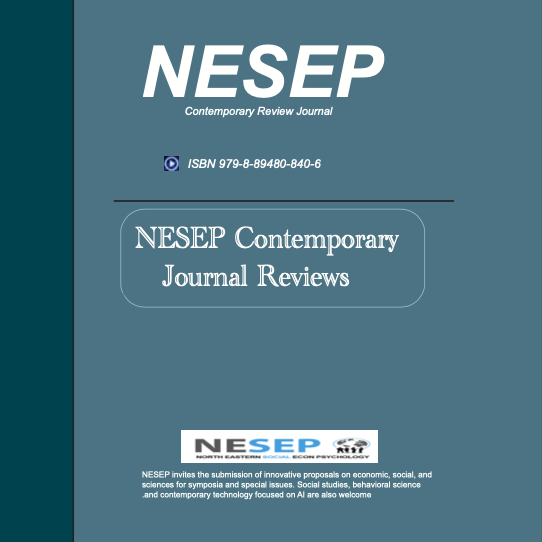Accepted Articles
We congratulate you on acceptance of your manuscript.

Annual Expo by the Journal of Young Explorers Meta and NESEP
- Fundamental or applied research
- Interdisciplinary research
- Judging on a rolling basis
- A work-in-progress research
- Completed research
- Unlimited topics and ideas
- ISBN 979-8-89480-840-6
- NESEP/NY-CSEF event at Harvard Club in NYC
Improving the Effectiveness of Neosporin on Escherichia coli by Supplementation
Abstract
Approximately 95,000 cases of E. coli related food poisoning are reported in the U.S. each year. The purpose of this study is to improve the effectiveness of the antibiotic Neosporin against bacteria by supplementing it with the polyphenol resveratrol. There is a great deal of information about the impact of polyphenols on the function of topoisomerase and the development of resistance to standard antibiotics. However, there is very little research on the impact of the polyphenol resveratrol combined with the standard antibiotic, neosporin, on the growth of Escherichia coli. This study was designed to investigate the effect of the common antibiotic neosporin enhanced with the polyphenol resveratrol on Escherichia coli. This study was completed by combining the neosporin with resveratrol and examining the zones of inhibition versus the control (water) using a Kirby-Bauer assay. Two different trials were conducted over the course of 4 days. The results of the Kirby-Bauer assay showed that, as hypothesized, the neosporin and resveratrol combined had the largest zones of inhibition. Thus, this novel combination could be a promising new method to address antibiotic resistance.
Reference
-
Bandele, O., Clawson, S. J., & Osheroff, N. (2008). Dietary Polyphenols as Topoisomerase II Poisons: B Ring and C Ring Substituents Determine the Mechanism of Enzyme-Mediated DNA Cleavage Enhancement. Chemical Research in Toxicology, 21(6), 1253–1260. https://doi.org/10.1021/tx8000785
-
CDC. (2022, October 5). How do germs become resistant? Centers for Disease Control and Prevention. https://www.cdc.gov/drugresistance/about/how-resistance-happens.html#:~:text=Antimicrobial%20resistance%20happens%20when%20germs
-
Daoud, N., Hamdoun, M., Hannachi, H., Gharsallah, C., Mallekh, W., & Bahri, O. (2020). Antimicrobial Susceptibility Patterns of Escherichia coli among Tunisian Outpatients with Community-Acquired Urinary Tract Infection (2012-2018). Current Urology, 14(4), 200–205. https://doi.org/10.1159/000499238
-
E. Coli (for Teens) - Nemours KidsHealth. (n.d.). Kidshealth.org. https://kidshealth.org/en/teens/e-coli.html#:~:text=Some%20types%20of%20E.
-
E. coli - Symptoms and causes. (2022, October 1). Mayo Clinic. https://www.mayoclinic.org/diseases-conditions/e-coli/symptoms-causes/syc-20372058#:~:text=Most%20healthy%20adults%20recover%20from
-
Hendley, J. O., & Ashe, K. M. (2003). Eradication of Resident Bacteria of Normal Human Skin by Antimicrobial Ointment. Antimicrobial Agents and Chemotherapy, 47(6), 1988–1990. https://doi.org/10.1128/aac.47.6.1988-1990.2003
-
Manso, T., Lores, M., & de Miguel, T. (2021). Antimicrobial Activity of Polyphenols and Natural Polyphenolic Extracts on Clinical Isolates. Antibiotics, 11(1), 46. https://doi.org/10.3390/antibiotics11010046
-
Meng, X., Zhou, J., Zhao, C.-N., Gan, R.-Y., & Li, H.-B. (2020). Health Benefits and Molecular Mechanisms of Resveratrol: A Narrative Review. Foods, 9(3), 340. https://doi.org/10.3390/foods9030340
-
Neosporin For Cuts? Some Doctors Say No. (2023, July 27). Bloomberg.com. https://www.bloomberg.com/news/newsletters/2023-07-27/neosporin-for-cuts-some-doctors-say-no
-
Nitiss, J. L., Soans, E., Rogojina, A., Seth, A., & Mishina, M. (2012). Topoisomerase Assays. Current Protocols in Pharmacology, CHAPTER, Unit3.3. https://doi.org/10.1002/0471141755.ph0303s57
-
Rahul, R., Maheswary, D., Damodharan, N., & leela, K. V. (2023). Unveiling Global Public Interest and Seasonal Patterns of Antibiotics and Antibiotic Resistance: An Infodemiology Study with Implications for Public Health Awareness and Intervention Strategies. International Journal of Medical Informatics, 105231. https://doi.org/10.1016/j.ijmedinf.2023.105231
-
Subramanian, M., Goswami, M., Chakraborty, S., & Jawali, N. (2014). Resveratrol induced inhibition of Escherichia coli proceeds via membrane oxidation and independent of diffusible reactive oxygen species generation. Redox Biology, 2, 865–872. https://doi.org/10.1016/j.redox.2014.06.007
-
The Real Truths About E. Coli | MemorialCare. (n.d.). Www.memorialcare.org. https://www.memorialcare.org/blog/real-truths-about-e-coli#:~:text=According%20to%20the%20Center%20for
-
Wang, X., Qi, Y., & Zheng, H. (2022). Dietary Polyphenol, Gut Microbiota, and Health Benefits. Antioxidants, 11(6), 1212. https://doi.org/10.3390/antiox11061212
-
Yilmaz, N., Agus, N., Bayram, A., Samlioglu, P., Sirin, M. C., Karaca Derici, Y., & Yilmaz Hanci, S. (2016). Antimicrobial susceptibilities of Escherichia coli isolates as agents of community-acquired urinary tract infection (2008-2014). Türk Üroloji Dergisi/Turkish Journal of Urology, 42(1), 32–36. https://doi.org/10.5152/tud.2016.90836